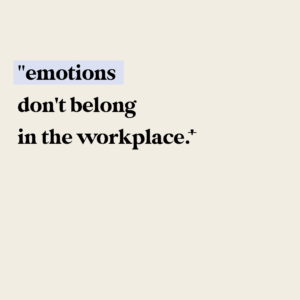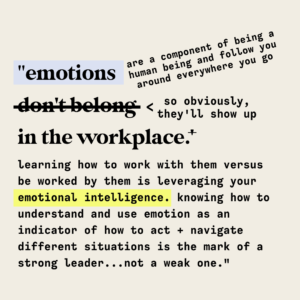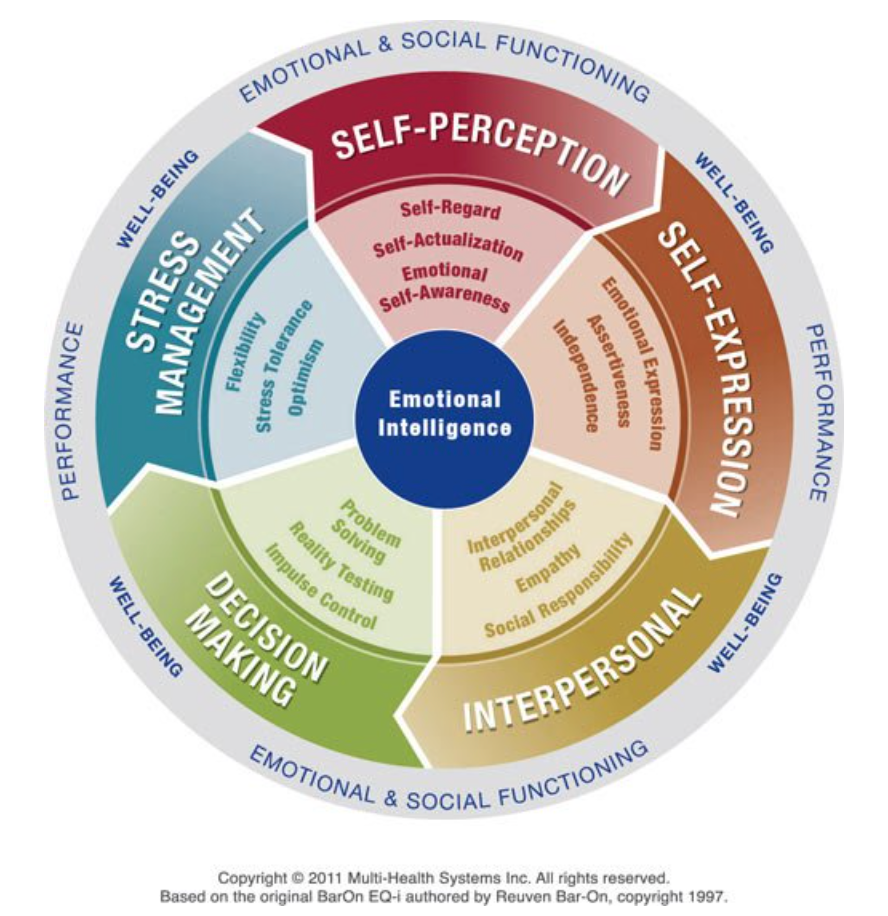
Tears. Ragey outbursts. Complete silence + the deer-in-the-headlights look. Measured communications of frustration, confusion, regret, or disappointment.
All of these are ways emotions get expressed in the workplace.
In recent years, the idea of cultivating a workplace culture that welcomes emotions—in all their forms—has been a hot topic of conversation. Dialogues encouraging empathy and compassion as parts of a company’s culture have come to the surface. Brené Brown popularized the idea of leading with vulnerability. Feedback about how a manager or team member communicates became more prevalent. An employee’s level of Emotional Intelligence started to become something recruiters and hiring managers cared about; moreso, in many cultures, than in years before. Business owners and entrepreneurs started looking at their ‘soft skills’ to complement their strategic expertise.
Long story short: more conversations about feelings and emotions and how they can, and do, show up at work became more popular, and in some cases, more pressing.
Encouraging people to be more themselves, more often, even at work? Unlocking more of their potential by encouraging their complete expression? Awesome. Yes please. More of this.
And.
Even the most feelings-friendly, vulnerability-accepting workplaces can be—and often are—missing the mark about the power of emotions—especially at work. Because emotions being ‘welcome’ in a workplace is one thing. Emotions going to WORK in a workplace…that’s another.
Business leaders often get some key points wrong when it comes to Emotional Intelligence. It’s time to get it right.
What We Know About Emotions
I’ll preface something: It’s not the generally accepted reality that emotions belong in the workplace.


In fact, I’ve heard first-hand accounts of friends and colleagues who have been told, right from their manager’s mouth, that their feelings don’t matter and don’t have any place at work.
Which leaves me saying, “Sure. Annnnnnnnnnnd…”
Because here’s the reality:
If you have human beings in your workplace, you inevitably have emotions.
Emotional Intelligence Should Allow People to be Human

Emotions are a naturally occurring experience that is inextricably tied to being a human being. Some of us may identify with, or choose to understand, our emotions more than others. And yet, we all have them.
Stemming from the Limbic System in our brains—the oldest part of the human brain in evolutionary terms—emotions are a product of certain parts of our brain being activated by stimulants and threats around us—both perceived and real—causing us to experience elevated joy, deep fear, anger, sadness, regret…the list goes on (and on…and on).
When that emotional brain is left unchecked, and our emotions become champagne bottle- or volcano-esque outpourings of feelings in every and any direction, that’s where we can run into problems. This is where processes and productivity can be hijacked, slowing momentum and causing ripples or ruptures that require time spent in repair + any needed reconciliation to restore a team’s trust in one another.
Like most things, there’s another side to the emotional coin. Because, even in the disruption that some big feels can cause, there’s an opportunity for leaders to see it as this:
Potential.
Potential for insight and information, for more creativity + new ideas, for breaking through broken systems or ways of working. And, potential for harnessing their innate power and turning it into momentum and trust-building opportunities.
The Untapped Potential of Emotional Intelligence

Emotional Intelligence (aka EQ) is more than self-awareness. It’s also more than freely expressing a feeling or emotion, and it’s more than empathy.
Though, all three of those things—self-awareness, emotional expression and empathy—are skills that make up the bigger picture of an individual’s EQ.
As defined by the EQ-i 2.0 (a model of Emotional Intelligence developed by Reuven Bar-On):
Emotional Intelligence is a set of emotional + social skills that collectively establish how well we:
- Perceive + express ourselves
- Develop and maintain social relationships
- Cope with challenges
- Use emotional information in an effective and meaningful way
It leverages the idea that when we build an understanding of relationship with our emotions, we can use them to help us know what skills to draw on to create the best possible outcome in any given situation.
You read that right: Emotional Intelligence is skill-centric.
-Jess Robson
And anyone—at any age—can learn to grow their skills in EQ.
Emotionally Intelligent individuals, leaders or teams don’t ONLY know how to identify their emotions but work with them…instead of getting worked by them.
They’re able to take the information surfacing with an emotional swell, assess a situation in front of them, take stock of the nuances of their environment + the people around them, and:
- discern what skills to dial up (and dial back) in order to establish deeper connections with team members or clients
- create safer workspaces for everyone to operate in
- build trust and stronger bonds
- unleash creativity and contribution
- the list goes on.
Sounds like a mouthful, and a lot of work…right?
And, once you get introduced to the skills, you start to see where and how they show up…everywhere, in every situation.
Meet The EQ-i 2.0

There are 5 ‘themes’ that house 15 skills that make up a comprehensive EQ based on the EQ-i 2.0 model:
While the image above is simply words on a wheel, when we debrief your unique Emotional Intelligence, you get the opportunity to see where your current EQ skillset lies—specifically marking your highest and lowest 3 skill sets. Then, you get to identify how your results are serving you, spot your areas of opportunity, and create growth-centric goals for yourself that can essentially empower you to be more effective in the areas of work or life that matter most.
And, it’s one of the most effective tools in turning insights into actions; offering not only an understanding of your behaviours that may (or may not) be working for you, while also offering specific actions you can take to create new outcomes where needed.
Here’s a couple extra things to know about the model, and how this version of EQ works:
- It’s all about context: where you are, what you’re experiencing now, and all that you’ve experienced to date.
- It’s all about balance: unlike traditional ‘testing’, a high score across all the skills doesn’t necessarily indicate a healthy EQ because we’re seeking a balance in our skills, and an ability to tap into the ones that can best serve us in any moment
- It’s all about growth: unlike IQ or other personality tests, it’s rooted in the idea that anyone can grow their EQ at any time in their life (aka it’s not fixed, and YOU are not fixed!)
- And it’s all about the bigger picture—not just your score: each score offers a gift, and a challenge. Both high and lower scores serve us in some way, AND provide an incredible piece of insight where a slight shift in how we leverage that skill could create incredible change; more peace, ease, comfort, connection, confidence…the list goes on.
An Example of EQ Results
A leader takes the EQ-i 2.0 and receives their result. As they review their report, they see they’ve scored quite high in Empathy and Interpersonal Relationships, yet have Self-Regard and Independence in their lowest 3 scores. Their first impression: pride! They love being a leader people can count on, and value the way they create service-built relationships. Then, when they sit down with their EQ coach, they realize that while the gift of being highly empathetic is that others feel safe to be vulnerable with them, they often find themselves drained from taking on the emotions of others. And, they see there’s an opportunity to create healthier boundaries for themselves that honour their personal needs for energetic and emotional restoration + rejuvenation so they show up refreshed and re-resourced when their people need them. With a few changes to their schedule and internal boundaries, they start to notice they have more energy to offer others, and start receiving more back from the relationships they’ve been pouring themselves into.
Tangible change through adapting to and adopting new habits that put these skills to work IS possible. It simply takes some practice (and perhaps the support of a coach to see and know what skills to leverage when) based on the outcomes you’re seeking!
Learning to Work Your EQ
Much like the muscles in the human body, these skills don’t go to work on their own; 99.9% of the time, using or leveraging one skill means recruiting 3-5 other skills to help you navigate a situation.
Knowing what to work when: that becomes the real work.
A great starting place is to take a personalized EQ-i 2.0 assessment + debrief. After completing an assessment, you’ll receive a report with your current EQ snapshot. Then, walk through it with a certified EQ practitioner (ahem…the human authoring this piece, for one).
Want to take it one step further? Seek out a coach who can support you in reaching your goals in your professional world (and personal life!) while integrating some of this work to expand your skills in EQ and bring more of it into all aspects of your life. In either case, reach out. I’d be stoked to have your back as you dive into your EQ.
Remember: we can all grow these emotional intelligence skills and feel the relief and the peace that can flow in through. So, and I say this with love, self-identifying ‘old dogs’ CAN learn new tricks; it’s their choice if they embrace the work…or not.
And specifically that—where emotions become the source of values-aligned actions that generate MORE momentum, creativity, team resilience (et al.)—is what’s possible when emotional intelligence is *really* at play inside a business, a team, or heck, a community.